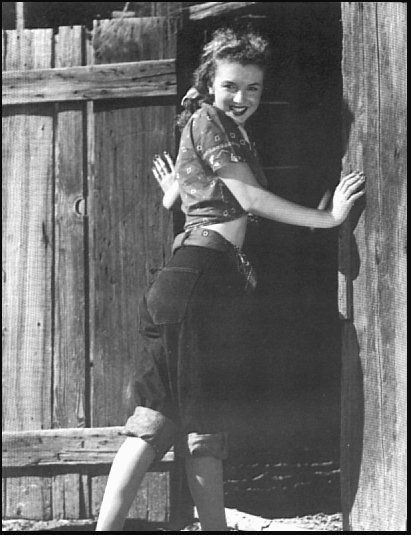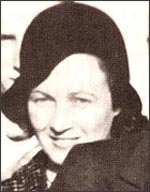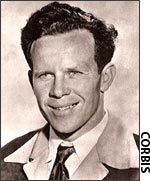 Norma Jeane Mortenson was born at 9:30 a.m. on June 1, 1926, at California's Los Angeles General Hospital to Gladys Pearl Monroe Baker. Norma's father was identified as Edward Mortenson on her birth certificate, yet it was unlikely that he was actually her father. According to Donald H. Wolfe in The Last Days of Marilyn Monroe, Norma Jeane's biological father was Stanley Gifford. Gifford and Gladys worked together as film cutters for Consolidation Film Industries, where a brief relationship allegedly developed between the two. However, by the time Gladys realized she was pregnant, she was on her own.
Norma Jeane Mortenson was born at 9:30 a.m. on June 1, 1926, at California's Los Angeles General Hospital to Gladys Pearl Monroe Baker. Norma's father was identified as Edward Mortenson on her birth certificate, yet it was unlikely that he was actually her father. According to Donald H. Wolfe in The Last Days of Marilyn Monroe, Norma Jeane's biological father was Stanley Gifford. Gifford and Gladys worked together as film cutters for Consolidation Film Industries, where a brief relationship allegedly developed between the two. However, by the time Gladys realized she was pregnant, she was on her own.
Norma Jeane was Gladys' third child. Norma's half-brother and half-sister were from Gladys' marriage to Jasper Baker, her first husband. Norwegian immigrant Martin E. Mortenson was Gladys' second husband, whom she had walked out on after four months of a dull marriage. Norma Jeane never really knew her half brother and sister because they were in the custody of their father, Jasper Baker.

Norma Jeane's childhood was an unhappy one, characterized by neglect, a series of foster homes, alleged sexual assault and emotional heartache. Her mother began working full-time shortly after Norma Jeane's birth in an effort to make ends meet. During Gladys' absence, Albert and Ida Bolender became the first foster parents to care for little Norma. She lived with the Bolenders for a about seven years and saw her mother mostly on the weekends. The Bolenders were Christian Scientists and devoutly religious, like Norma's mother. They were extremely strict with Norma Jeane because they believed that a strong moral and religious background would benefit the impressionable little girl throughout her life.
At the age of seven, Norma lived with her mother for a brief period of time before she was admitted to a rest home in 1934. Gladys suffered from what doctors then diagnosed as paranoid schizophrenia. Schizophrenia, a largely inherited mental condition, ran rampant in Gladys' family. Donald H. Wolfe describes Gladys' mother, Della Monroe Grainger, as a manic depressive, and her father, Otis Monroe, also as a manic depressive. Psychosis contributed to the death of Gladys' great grandfather and the institutionalization of Gladys' maternal grandmother. Moreover, according to Kirk Wilson's book Unsolved Crimes, Norma's half brother would also be diagnosed years later with the same condition.
Following her mother's admittance, Norma Jeane lived with a close friend of her mother's named Grace McKee until Grace married in 1935. Following her stay with Grace, Norma Jeane was sent to live for two years in the Los Angeles Orphan's Home. She was then shuffled between a series of seven other foster homes before returning to live with Grace and her husband in 1941.
As an adult, she would later claim that while at one of the foster homes, she was sexually assaulted. During 1934, the foster family Norma Jeane was living with rented a room to an actor known as Mr. Kimmel. He was considered by the family to be a respectable, yet austere man. One day, he allegedly pulled the eight-year-old Norma Jeane into his room and sexually assaulted her. When she tried to tell her foster mother of Mr. Kimmel's atrocious behavior, she was rebuffed. Her foster mother refused to believe that Mr. Kimmel would do such a thing to a young and innocent girl.
Following Norma Jeane's later transformation to Marilyn Monroe, she was quoted as saying about her youth, "The world around me then was kind of grim. I had to learn to pretend in order to...I don't know...block the grimness. The whole world seemed sort of closed to me...[I felt] on the outside of everything and all I could do was to dream up any kind of pretend game."
In 1942, Grace and her husband were facing financial difficulties and decided to move to the East Coast to start a new beginning. They decided it would be best for Norma Jeane not to come, so Grace encouraged Norma Jeane to marry the son of a neighbor, 21-year-old Jim Dougherty. Following a courtship lasting only several weeks, Jim Dougherty and Norma Jeane married on June 19, 1942. Norma Jeane had only just turned 16 several weeks earlier. Although the marriage was one of convenience, she earnestly tried in the beginning to be a good wife and housekeeper. It was not a role that came naturally to her.
In 1943, Jim joined the Merchant Marines and a year later he was shipped off to New Guinea and then to the Pacific during the war. To fill the time and put extra money in her pocket, Norma Jeane worked at an aircraft and parachute-inspecting plant named Radio Plane Munitions Factory, where she inspected and painted planes. However, the job did little to ease her boredom and she grew increasingly lonely and insecure during her husband's absence. Norma Jeane began to escape into alcohol.

In mid-1944, Norma Jeane was offered an exciting break and a way to escape the humdrum life, which she was beginning to resent. An army photographer named Private David Conover was doing a piece for Yank magazine on women at work for the war effort, when he spotted the uncommon and surprisingly natural beauty of Norma Jeane. Conover paid her $5 an hour to model for him for several weeks, and the two traveled around southern California on a photo shooting session. The pictures were quickly produced and it wasn't long before she gained the attention of the Blue Book Model Agency.
Within a year Norma Jeane's popularity skyrocketed and she appeared on the covers of 33 national magazines. Her modeling career quickly became a success, but her relationship with Dougherty began to fail. Norma Jeane's fear of loneliness and boredom propelled her into several affairs during her marriage.
Although there are many reports of men who claimed to have been Norma Jeane's lover during her earlier modeling days, only a few accounts were ever substantiated. One such affair was with 32-year-old photographer André de Dienes. During a photo shoot of Norma, he became infatuated with her beauty and fell in love with her wholesomeness. According to de Dienes, he urged her to divorce her husband so that he could marry her. Norma eventually agreed to marry de Dienes, but she quickly withdrew the offer and remained married to Dougherty.
It is unclear exactly how many lovers Norma had during her first marriage. However, what was clear was that she was no longer satisfied in her marriage. According to a later interview, she claimed her marriage was neither unhappy nor painful just extremely boring. During the summer of 1946 Norma Jeane filed for divorce, an event that would be a turning point in her life.
Norma Jeane set her sights higher and began to dream of becoming a movie star.
One month after her 20th birthday, she interviewed with casting director Ben Lyon at 20th Century Fox. Several days later she was called to do her first screen test, which was followed by a contract delivered on August 26, 1946. She was offered the sum of $75 a week, to be reviewed after six months, to act for the studio.
The contract had one condition -- that she change her name from Norma Jeane Dougherty to something more catchy and alluring. At first, the studio decided to change her name to Carol Lind, however the name didn't fit her and it was eventually scrapped. Ben Lyon then suggested the name Marilyn, because it reminded him of his favorite actress Marilyn Miller. Norma Jeane was pleased with the suggestion and added the last name Monroe, which was her mother's maiden name. It was then that Hollywood launched the new face and name -- Marilyn Monroe.
CHAPTERS
BIOGRAPHY MAIN
1.Norma Jeane
2.Struggle To Stardom
3.Sex Symbol
4.Unhappily Married
5.The Kennedy Connection
6.Marilyn's Death (Undisputed Facts)
7.Conflicting Facts
8.Theories
Marilyn's Will